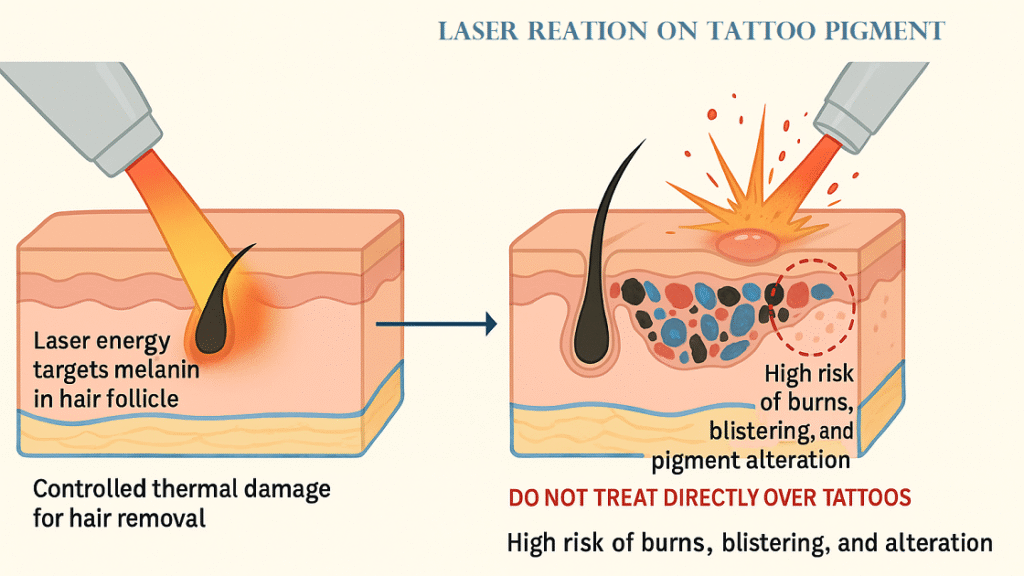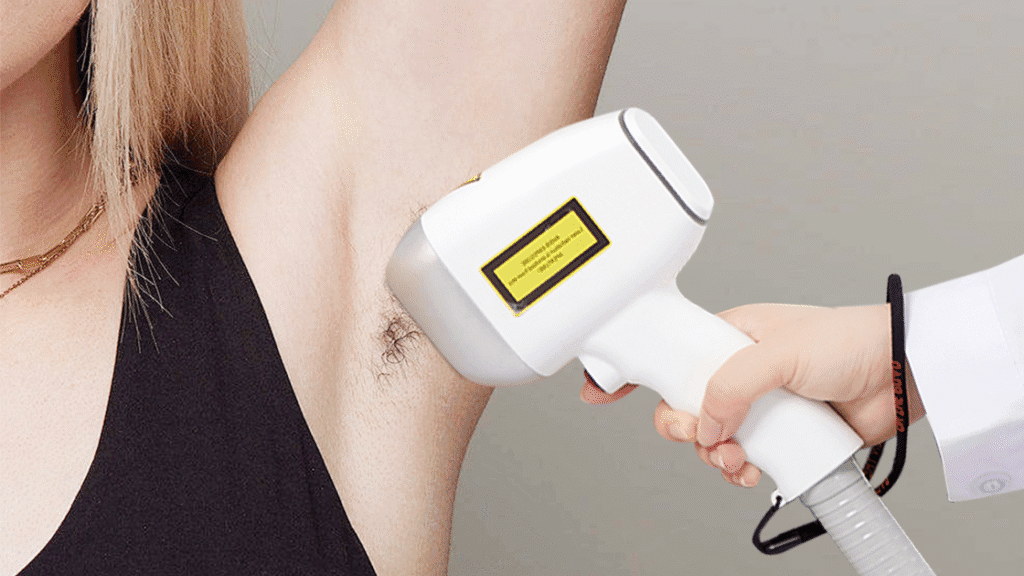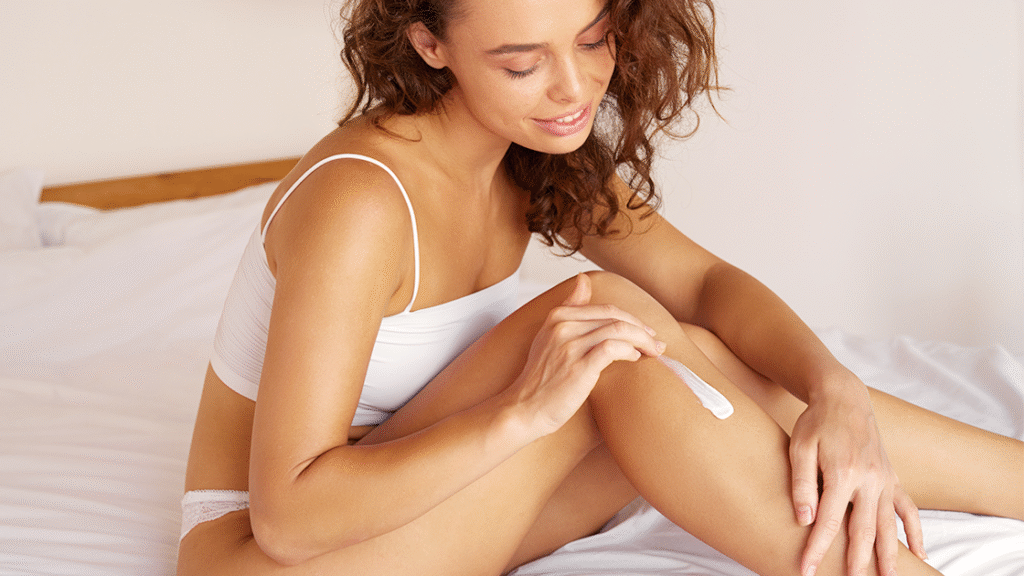1. Introduction
The intersection of cosmetic enhancement and skin modification has created unique challenges in modern aesthetic medicine. As both tattooing and laser hair removal continue to surge in popularity, understanding their compatibility becomes crucial for informed decision-making.
1.1 Why the Question Matters
The compatibility between laser hair removal and tattoos represents a significant concern in dermatological practice. Laser hair removal cannot be used to remove hair on tattoos, as the laser will detect the pigment in the tattoo instead of the hair and can burn the skin or cause damage to both skin and tattoo. This incompatibility stems from fundamental differences in how laser energy interacts with various types of pigmentation within the skin matrix. Understanding these interactions is essential for preventing adverse outcomes, including thermal injuries, pigment distortion, and permanent scarring. The consequences of improper treatment can result in both aesthetic disfigurement and potential legal liability for practitioners.
1.2 Growing Popularity of Both Tattoos and Laser Hair Removal
Contemporary society has witnessed unprecedented growth in both tattoo artistry and laser-based aesthetic procedures. The convergence of these trends has created a substantial population requiring specialized treatment approaches. Modern diode laser technology has revolutionized hair removal efficacy, while advanced tattooing techniques have expanded artistic possibilities. This demographic overlap necessitates comprehensive understanding of treatment limitations and alternative approaches. The increasing sophistication of both procedures demands equally sophisticated safety protocols and patient education initiatives.
1.3 Overview of Key Risks and Considerations
The primary concerns surrounding laser hair removal on tattooed skin encompass thermal injury, pigment alteration, and permanent tissue damage. Direct laser contact on tattooed skin for hair removal is described as “a recipe for severe skin damage and a ruined design”. These risks are compounded by variables including tattoo age, ink composition, anatomical location, and individual skin characteristics. Professional practitioners must weigh these risks against patient expectations while maintaining ethical treatment standards. The complexity of these interactions requires specialized knowledge and careful case-by-case assessment.
2. How Laser Hair Removal Works
Understanding the fundamental mechanisms of laser hair removal is essential for comprehending why tattoos create such significant complications. The science behind selective photothermolysis forms the foundation of safe and effective treatment.
2.1 Laser Technology Basics: Targeting Melanin
Diode laser systems operate on the principle of selective photothermolysis, utilizing specific wavelengths to target chromophores within hair follicles. The laser targets the pigment melanin located in the hair follicle, with the pigment absorbing light and converting energy to heat, which weakens the hair follicle. This selective targeting relies on the differential absorption properties of melanin versus surrounding tissue. The wavelength selection, typically between 755-1064 nanometers in diode systems, maximizes melanin absorption while minimizing collateral thermal damage. Pulse duration and energy density parameters are carefully calibrated to achieve optimal follicular destruction while preserving epidermal integrity.
2.2 What Happens When Laser Meets Pigment
The interaction between laser energy and pigmented structures involves complex photophysical processes. When photons encounter melanin molecules, they undergo absorption, converting light energy into thermal energy through vibrational and rotational molecular motion. This rapid heating creates localized temperatures sufficient to denature follicular proteins and disrupt cellular structures. The thermal diffusion time determines the extent of collateral damage, with optimal parameters ensuring heat confinement within the target follicle. Excessive energy delivery or prolonged exposure can result in epidermal burns and scarring.

2.3 Laser Sensitivity to Pigment Density
Pigment concentration significantly influences laser energy absorption and subsequent thermal effects. Higher melanin densities result in increased photon absorption and more rapid temperature elevation. This relationship explains the enhanced efficacy of laser treatment on darker hair and the increased risk of adverse effects in hyperpigmented skin. The distribution pattern of pigment also affects treatment outcomes, with uniform pigmentation providing more predictable results than irregular or patchy distributions. Understanding these relationships is crucial for parameter selection and safety optimization.
2.4 Why Tattoo Ink Reacts Differently from Hair Follicle Melanin
Tattoo pigments differ fundamentally from endogenous melanin in their chemical composition, particle size, and tissue distribution. When diode laser is directed towards treatment areas, melanin in hair follicles absorbs the laser energy, which is converted to heat, reducing hair follicles’ ability to generate hair. However, tattoo inks contain various inorganic and organic compounds with unpredictable absorption characteristics. The depth of tattoo pigment deposition in the dermis creates additional complexity, as these particles may absorb laser energy intended for follicular targets. This competition for photon absorption can result in insufficient follicular heating and excessive dermal thermal injury.
3. Tattooed Skin and Laser Hair Removal: What You Need to Know
The interaction between laser energy and tattooed skin creates a complex cascade of potential complications that extend far beyond simple treatment inefficacy. Understanding these risks is fundamental to safe practice.
3.1 Laser Interaction with Tattoo Ink
Tattoo inks represent a heterogeneous mixture of pigments with varying optical properties and thermal responses. Unlike the relatively uniform absorption characteristics of melanin, tattoo pigments may contain metals, organic compounds, and synthetic dyes with unpredictable laser interactions. Some pigments may undergo photochemical reactions, creating toxic byproducts or altering color composition. The particle size distribution within tattoo ink also influences thermal diffusion patterns, potentially creating non-uniform heating and unpredictable tissue responses. Professional tattoo inks may contain stabilizers and carrier compounds that further complicate laser interactions.
3.2 Risk of Skin Burns and Blistering
Diode laser treatment can result in postoperative hypersensitivity and possible burns manifested by blisters and scabs. When applied to tattooed skin, these risks are dramatically amplified due to increased pigment density and altered thermal conductivity. The concentration of absorbing particles can create focal points of excessive heating, leading to immediate thermal injury. Blistering typically occurs when epidermal temperatures exceed 60°C, causing protein denaturation and cellular death. The presence of tattoo pigments can lower the threshold for thermal injury by creating additional heat sources within the treatment zone.
3.3 Pigment Distortion or Fading
Laser exposure can cause fading or distortion of tattoos, representing one of the most common and aesthetically significant complications. The selective absorption of laser energy by specific pigment colors can create uneven fading patterns, fundamentally altering the artistic integrity of the tattoo. Certain colors, particularly those containing metallic compounds, are more susceptible to laser-induced changes. The irreversible nature of pigment alteration makes this complication particularly problematic, as restoration of the original tattoo appearance may be impossible even with corrective tattooing techniques.
3.4 Potential for Scarring or Permanent Damage
Thermal injury to tattooed skin can result in permanent scarring through several mechanisms. Excessive heat delivery can cause coagulative necrosis of dermal structures, leading to fibroblast activation and collagen deposition. The presence of foreign pigment particles may exacerbate inflammatory responses, increasing the likelihood of hypertrophic or keloid scar formation. Scarring not only compromises aesthetic outcomes but may also preclude future treatment options, including tattoo modification or removal procedures.
3.5 Why Tattoos Often Can’t Be Treated Directly
The primary reason for this incompatibility lies in the way the laser targets pigmentation, as tattoos consist of ink pigments embedded in the skin. The fundamental conflict between hair removal objectives and tattoo preservation creates an irreconcilable treatment dilemma. Standard laser parameters optimized for melanin targeting become inappropriate when tattoo pigments are present. The unpredictable nature of tattoo ink responses to laser energy makes standardized treatment protocols impossible, requiring individualized risk assessment for each case.
4. Safe Hair Removal Strategies Around Tattoos
Developing effective hair removal strategies for individuals with tattoos requires creative approaches that prioritize safety while maximizing treatment efficacy. Professional practitioners must master various techniques to accommodate diverse clinical scenarios.
4.1 Skipping the Tattooed Area: Why It’s the Norm
In most cases, laser hair removal can be done safely and effectively around tattoos, making selective avoidance the standard of care. This approach involves careful mapping of tattooed areas and systematic exclusion from laser treatment zones. The technique requires precise beam control and experienced technician skills to maintain treatment continuity. Boundary definition becomes critical when tattoos have irregular borders or fade into surrounding skin. Clear communication with patients regarding treatment limitations helps establish realistic expectations and prevents dissatisfaction with incomplete hair removal.
4.2 Marking Tattoo Boundaries for Safety
Skilled technicians can work around inked artwork, keeping the tattoo safe while effectively removing unwanted hair by carefully covering tattoos with white cloth or special protective materials. Precise boundary demarcation using removable markers or protective shields ensures consistent safety margins throughout treatment sessions. The marking process must account for tattoo fade zones and potential ink migration over time. Digital photography and treatment mapping can provide valuable documentation for subsequent sessions, ensuring consistent exclusion zones and treatment parameters.
4.3 Laser Hair Removal Between Tattoos or in Untattooed Zones
Strategic treatment planning allows for effective hair removal in areas between multiple tattoos or in clearly defined untattooed regions. This approach requires careful beam positioning and potentially modified treatment parameters to account for proximity effects. The technique is particularly valuable for individuals with multiple small tattoos or specific anatomical distributions. Cooling systems and protective measures become especially important when working in close proximity to tattooed areas to prevent inadvertent thermal damage.
4.4 Manual Methods for Tattooed Regions
Traditional hair removal methods remain the safest option for tattooed areas, despite their temporary nature and increased maintenance requirements. Waxing, threading, and careful shaving can maintain hair-free appearance without risking tattoo integrity. These methods require patient education regarding proper technique and frequency to minimize skin irritation. The integration of manual methods with laser treatment for non-tattooed areas creates comprehensive hair removal solutions that address patient needs while maintaining safety standards.
4.5 Can You Tattoo Over Laser-Treated Skin?
It is completely safe to have a tattoo after laser hair removal, provided the skin is completely healed from any laser treatment before getting the tattoo. The healing process typically requires 4-6 weeks, during which skin integrity and collagen structure return to baseline. Pre-tattoo laser treatment can actually improve tattoo outcomes by creating uniform skin texture and reducing interference from hair follicles. Planning treatment sequences becomes important for individuals considering both procedures, with laser hair removal generally recommended as the preliminary step.

5. Can You Ever Laser Over a Tattoo Safely?
While direct laser treatment of tattooed skin remains contraindicated in most circumstances, specialized protocols and advanced technologies may offer limited exceptions under specific conditions.
5.1 Specialized Protocols for Specific Tattoo Colors
Certain tattoo colors exhibit more predictable laser responses, potentially allowing for modified treatment approaches under expert supervision. Black and dark blue pigments, which primarily absorb near-infrared wavelengths, may be more compatible with specific laser parameters than complex color mixtures. However, even these seemingly straightforward cases require extensive testing and monitoring. The development of tattoo-safe laser protocols remains an active area of research, with preliminary studies suggesting possible applications for specific clinical scenarios.
5.2 Protective Cover Shields and Carbon Blockers
Advanced protective technologies, including reflective shields and carbon-based blocking agents, may provide some protection for tattoos during adjacent laser treatments. These systems work by creating physical barriers or absorbing laser energy before it reaches tattoo pigments. The effectiveness varies significantly based on tattoo characteristics and proximity to treatment areas. Implementation of protective systems requires specialized training and equipment, limiting their availability to advanced treatment centers with appropriate expertise.
5.3 Importance of Technician Training and Experience
Procedures should only be performed at skin clinics with highly trained and reliable laser technicians. The complexity of laser-tattoo interactions demands extensive specialized knowledge and hands-on experience with diverse clinical scenarios. Advanced training programs should include theoretical understanding of laser physics, tattoo composition, and risk management strategies. Certification requirements and continuing education ensure practitioners maintain current knowledge of evolving safety standards and technological developments.
5.4 When Laser Tattoo Removal Might Be the First Step
For individuals with small, strategically located tattoos that significantly interfere with desired hair removal areas, laser tattoo removal may represent a viable preliminary step. This approach requires careful cost-benefit analysis and realistic timeline expectations, as tattoo removal typically requires multiple sessions over months or years. The decision to pursue tattoo removal should consider factors including tattoo size, location, pigment composition, and patient commitment to the extended treatment process.
6. Expert Guidelines and Recommendations
Professional medical organizations have established comprehensive guidelines for laser hair removal in the presence of tattoos, emphasizing safety protocols and practitioner responsibilities. The American Society for Laser Medicine and Surgery recommends complete avoidance of laser hair removal over tattooed areas, citing unpredictable pigment responses and significant complication risks. International guidelines echo these recommendations, emphasizing the importance of thorough patient consultation and informed consent processes. Professional liability considerations require practitioners to document treatment limitations and obtain specific acknowledgment of risks associated with proximity treatments. Regular guideline updates reflect evolving understanding of laser-tissue interactions and technological advances. Evidence-based practice standards emphasize the importance of peer-reviewed research in guiding treatment decisions, with ongoing studies investigating novel approaches to this clinical challenge.
7. Real-Life Experiences and Case Studies
Clinical experience provides valuable insights into the practical challenges and outcomes associated with laser hair removal in tattooed individuals.
7.1 Success Stories: Hair Removal Around Tattoos
Successful laser hair removal around tattoos provides permanent hair reduction, saving patients the hassle of waxing and shaving for the rest of their lives. Case studies demonstrate excellent outcomes when proper safety protocols are followed and realistic expectations are established. Patients typically report high satisfaction with treatment results and appreciate the convenience of reduced maintenance requirements. Long-term follow-up studies show sustained hair reduction in non-tattooed areas without adverse effects on adjacent tattoos when appropriate safety margins are maintained.
7.2 What Went Wrong: Burn Cases and Lawsuits
Documentation of adverse outcomes provides important learning opportunities for the medical community. Reported cases of thermal burns, tattoo distortion, and permanent scarring typically involve protocol violations, inadequate training, or equipment malfunction. Legal proceedings emphasize the importance of proper informed consent and adherence to established safety standards. Analysis of complication cases reveals common factors including inadequate patient screening, inappropriate parameter selection, and insufficient protective measures.
7.3 Patient Reviews and Common Complaints
Patient feedback highlights the importance of clear communication regarding treatment limitations and expected outcomes. Common complaints include incomplete hair removal, longer treatment times, and increased costs associated with working around tattoos. Positive reviews emphasize the value of practitioner expertise and comprehensive treatment planning. Online reviews and patient testimonials provide valuable insights into patient satisfaction factors and areas for service improvement.
7.4 Lessons Learned
Clinical experience has established several key principles for successful treatment of tattooed individuals. These include thorough pre-treatment assessment, conservative parameter selection, comprehensive patient education, and realistic expectation setting. The importance of ongoing practitioner education and equipment maintenance cannot be overstated. Continuous quality improvement processes help identify potential issues before they result in adverse outcomes.
8. Alternatives to Laser Hair Removal for Tattooed Skin
Effective hair removal solutions exist for individuals with extensive tattooing or those preferring alternative approaches to laser treatment.
8.1 Waxing and Sugaring
Traditional waxing and sugar-based hair removal methods remain safe and effective options for tattooed skin. These techniques provide several weeks of hair-free results without risk to tattoo integrity. Modern waxing formulations minimize skin irritation and provide comfortable treatment experiences. Sugar waxing, or sugaring, offers additional benefits with its natural ingredients and reduced risk of allergic reactions. Both methods effectively remove hair from the root, providing longer-lasting results than shaving. Professional waxing services can accommodate sensitive tattooed areas while maintaining aesthetic results comparable to laser treatment in terms of immediate hair removal.

8.2 Electrolysis (Pros and Cons)
Electrolysis offers permanent hair removal through targeted follicular destruction using electrical current rather than light energy. This method can safely treat individual hairs within tattooed areas without affecting ink pigments. The FDA recognizes electrolysis as the only truly permanent hair removal method available. However, the treatment is time-intensive and may cause discomfort in sensitive areas, requiring multiple sessions over extended periods. Each hair follicle must be treated individually, making the process suitable for smaller areas. The precision of electrolysis makes it ideal for small tattooed areas or for treating residual hairs missed by other methods, though costs can accumulate due to session frequency.
8.3 Depilatory Creams (and Why They’re Tricky)
Chemical depilatories work by breaking down hair protein structures through alkaline formulations containing calcium thioglycolate or potassium thioglycolate. While these products don’t directly affect tattoo pigments, they may cause skin irritation that could impact tattoo appearance through inflammation or allergic reactions. The high pH levels required for effective hair dissolution can be harsh on sensitive tattooed skin. Patch testing becomes especially important for tattooed individuals due to potential sensitivity and the risk of chemical burns. The temporary nature of chemical hair removal requires frequent application every few days, making it less convenient than permanent solutions and potentially expensive over time.
8.4 Choosing the Right Method for Tattooed Areas
Method selection depends on individual factors including tattoo size and location, hair characteristics, skin sensitivity, pain tolerance, and budget considerations. Large tattoos may require different approaches than small decorative pieces, while facial tattoos present unique challenges compared to body art. Hair density and coarseness also influence method effectiveness and treatment frequency requirements. Combination approaches often provide optimal results, using laser treatment for large untattooed areas and alternative methods for smaller tattooed regions. Professional consultation helps determine the most appropriate treatment strategy for each individual case, considering long-term maintenance requirements and lifestyle factors that may impact treatment adherence and satisfaction.
9. Pre-Treatment and Aftercare Tips
Comprehensive pre-treatment preparation and post-treatment care are essential for optimal outcomes and complication prevention.
9.1 Consulting a Licensed Professional
Initial consultation with qualified practitioners ensures proper assessment of individual risk factors and treatment options specific to tattooed skin. Licensed professionals can evaluate tattoo characteristics including age, ink composition, and artistic complexity alongside skin type and hair patterns to develop appropriate treatment strategies. Board-certified dermatologists or certified laser technicians possess the expertise necessary to navigate complex cases safely. Verification of practitioner credentials, facility licensing, and insurance coverage provides additional safety assurance and legal protection. Comprehensive consultation should include discussion of alternative options, realistic timeline expectations, potential complications, and detailed cost considerations including maintenance requirements for optimal long-term results.
9.2 Spot Testing and Skin Patch Trials
Pre-treatment testing in inconspicuous areas allows assessment of individual skin responses to laser parameters and identifies potential adverse reactions before full treatment. Patch testing should include areas both adjacent to and distant from tattoos to evaluate comparative responses and thermal diffusion patterns. Test parameters typically use conservative energy settings with gradual increases to establish safety thresholds. Results guide parameter selection and safety margin determination for full treatment sessions while documenting baseline skin conditions. Documentation of test responses provides valuable reference information for subsequent treatments and complication management, including photographic records and detailed parameter logs for quality assurance and legal protection purposes.
9.3 Post-Treatment Care for Tattooed vs. Untattooed Skin
Post-treatment care protocols may require modification for areas near tattoos due to potentially altered healing responses and increased sensitivity. Enhanced sun protection becomes especially important for tattooed areas to prevent pigment changes, with broad-spectrum SPF 30+ sunscreen recommended for minimum six weeks post-treatment. Moisturizing regimens should use tattoo-safe, fragrance-free products that won’t interfere with ink stability or cause allergic reactions. Avoid petroleum-based products that may clog pores or interfere with healing. Monitoring protocols should include specific assessment of tattoo appearance, color changes, and any signs of inflammation that might indicate complications requiring immediate professional attention and intervention.
9.4 What to Do if Irritation Occurs
Immediate management of post-treatment irritation involves cooling measures such as cold compresses or aloe vera gel, topical anti-inflammatory agents like hydrocortisone cream, and protection from further trauma or environmental stressors. Any changes in tattoo appearance including color shifts, swelling, or unusual discharge require prompt professional evaluation and documentation with photographs for medical records. Emergency protocols should be established for severe reactions or suspected thermal injury, including contact information for after-hours care and clear instructions for emergency room visits. Patient education regarding normal healing responses versus concerning symptoms helps ensure appropriate care-seeking behavior and prevents unnecessary anxiety while maintaining vigilance for serious complications.
9.5 Tattoo Maintenance After Laser Hair Removal

Long-term tattoo care may require modification following laser treatments in adjacent areas due to potential changes in skin texture and sensitivity. Enhanced moisturizing using tattoo-specific aftercare products and sun protection help maintain tattoo vibrancy and prevent premature aging or color degradation. Regular dermatological evaluation monitors for any delayed changes or complications that may emerge weeks or months after treatment completion. Professional tattoo touch-up services can address any minor changes that occur over time, though major modifications may be necessary if significant damage occurs. Maintaining detailed treatment records helps track any tattoo changes and assists professional tattoo artists in planning potential restoration work if needed.
10. Conclusion
Laser hair removal and tattooed skin present unique challenges that require expert planning. Direct laser treatment over tattoos is typically avoided due to the risk of burns, pigment distortion, and scarring. However, hair removal around tattoos can be performed safely when experienced professionals follow strict protocols and avoid direct laser exposure on inked areas. With careful pre-treatment assessment and realistic expectations, patients can achieve effective results while protecting their body art. Alternative methods—like shaving or electrolysis—may be used on tattooed zones when necessary. As technology advances, new approaches may improve the safety and scope of laser treatments for tattooed skin. Until then, combining laser on untattooed areas with alternative solutions offers a reliable strategy. Consulting qualified providers ensures a customized treatment plan that prioritizes both results and skin safety.
11. FAQs
Yes, lasers used for hair removal can cause permanent pigment distortion, fading, or even burns if directed at tattooed skin. That’s why professionals avoid lasering directly over tattoos.
No. No current hair removal laser is universally safe across all tattoo ink colors. Dark inks, in particular, absorb laser energy aggressively, increasing the risk of skin trauma.
Shaving is the most common and safest method. Electrolysis may also be used, but it should be administered by a licensed professional familiar with tattooed skin.
Most clinics maintain a 2–3 cm safety margin. Skilled technicians mark the tattoo edges and avoid overlapping the laser path, protecting inked skin from unintended exposure.
Lasering near a tattoo typically won’t cause fading, but scattered energy may affect edges if not shielded properly. Using carbon blockers or physical barriers is essential.
Yes, in many cases. Electrolysis targets individual hair follicles with electric current, not light. It poses less risk to tattoo pigment, though results take longer to achieve.








